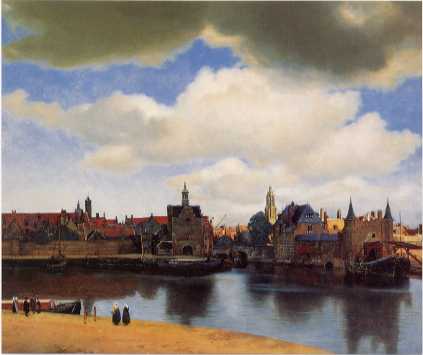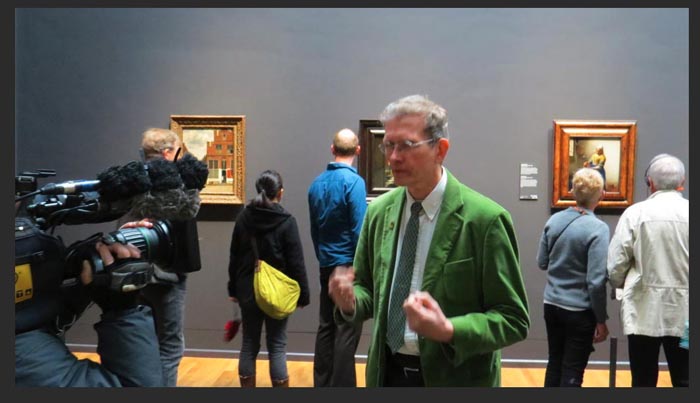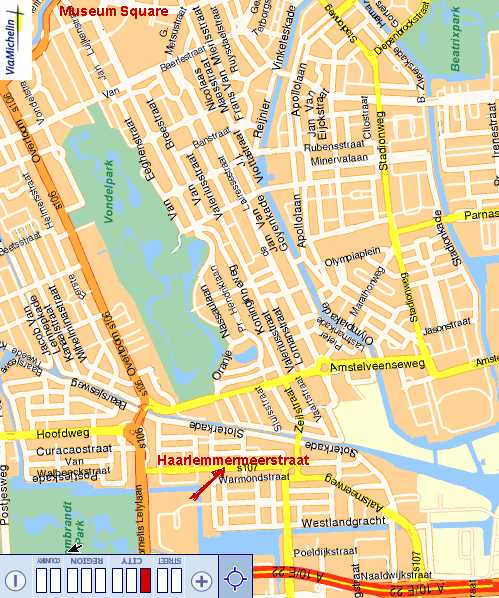

The Pride of Place: Dutch Cityscapes of the Golden Age is a wonderful exhibition catalogue. It refers to the two nearly identical exhibitions consecutively held in Washington, DC up to May, 2008 and in the Mauritshuis in The Hague up to January 11, 2009 under the similar title Bewonderde Stad, Hollandse Stadsgezichten uit de Gouden Eeuw (Admired City, Dutch Cityscapes from the Golden Age).
For various reasons some paintings were shipped to only one of the two exhibition venues. The huge View of the Hague by Jan van Goyen, with a stunning width of 4,6 meters (13 feet) travelled across the ocean from the History Museum in The Hague to Washington, DC - whereas the celebrated View of Delft by Vermeer, the showpiece on the book cover and Dutch PR posters remained in The Hague for reasons of fragility and conservation, amongst others. Trading off temporary loans between museums is in fact a high level game between museum boards and directors in which not only the state of conservation play a role. Goodwill, past history and power play remain keywords.
In Washington the exhibition consisted of 46 paintings and 22 maps, atlases, and illustrated books – thus forming a good survey of the Dutch cityscape tradition as it developed in the seventeenth century.
In The Hague the exhibition consisted of about 45 paintings as well (exact figure has been requested).
The two main articles written by Boudewijn Bakker and Arthur K. Wheelock, Jr. are high quality overviews, in which these two specialists share their knowledge about the current state of art history research.
This exhibition had one predecessor, back in 1977. In that year the Amsterdam Historic Museum showed an exhibition and published a catalogue on Dutch cityscapes written by Richard J. Wattenmaker. It was a brave first attempt to examine townscape views in the broad perspective of Dutch seventeenth century art. Since then, published research on single artists or single paintings has brought new facts and opinions, deepening our insight on a number of key concepts. We now have a richer knowledge of for instance, the apparent reasons for producing this new specialisation of townscape painting (also taking into account the relationship between artist and patron), but also know more about biographical details, accurate dating, topographical accuracy and other key elements. Nevertheless, up until 2008 no synthesis had been produced in the art history field. This exhibition and exhibition catalogue do a beautiful job of gathering and sorting this new knowledge and disseminating it to a wide public of specialists and art lovers.
Each of the 52 entries shows the work of art in full colour with one to three pages page of discussion. It is a relief to discover that art history hobbyhorses, such as discussions about the meaning of the painting, and references to emblem books and hidden symbolism, that were such a plague in art history academia for the last 40 years, have been neatly circumvented.
The demarcation line between the public and the private – the street as the bustling civic arena, as opposed to the quiet quarters behind the front door of a private home form a fascinating theme in the field of cityscapes. This theme may also inform us about the core of modern family life as it first developed in the urbanized Netherlands in the sixteenth and seventeenth centuries. However, on p.150 one author of the entries on paintings, Dullaart, chooses academic phraseology when she uses the slippery term “complexity”, a current pet catchwords in higher academia.
Technical research has yielded fascinating new information that is also discussed in this catalogue. One example is the highly unusual painting technique employed by Jan van der Heyden. He used his privately developed stamp-with-paint technique to impress the shapes of single brick shapes into the wet paint of a painted brick façade, resulting in an eerie life-like effect. Restorers who made use of a microscope discovered this unique technique while working on the painting (page 9).
Some paintings have been used as a jumping board to recount the highly convoluted political historical background of local Dutch cities – each with their own burgomasters, councils and courts of law. Generally city dwellers strove for optimal trade, commerce and wealth. National defence and taxation were matters for central political circles in The Hague; the States General, princes and ‘stadtholder’ (a political functionary). The military elite, led by the princes of the house of Orange also resided in The Hague. War was their best tool for increasing their influence and wealth – as war makes states and states make war in an everlasting circle.
The 2008 exhibition catalogue also touches on the key role of religion in seventeenth century cities. As a reader may not have extensive knowledge of this background information, this discussion is necessary and well done.
Basically the old view among historians was that of the anti-Spanish Calvinist Protestants versus the pro-Spanish Catholic group, with a small percentage of tolerant Remonstrant Protestants on the sidelines. This triangle of faiths provides the regular theoretical backdrop of power. On p.132 an interesting observation is made. The author writes about the question as to whether the politicians in the Republic had full control over the institution of the Reformed (Calvinist) Church. She postulates that the Remonstrants were against the politicians’ influence, and the Calvinist Contra-Remonstrants, in favour of it.
Recent studies have however pointed out that this struggle during the so-called 80 years war with Spain was not so much a heroic textbook war of national liberation, as an ugly guerrilla civil war with many casualties on both sides and a real chance for out and out civil war when the Remonstrants were sidelined in 1618.
One serious drawback to the book is that the articles, entries on paintings and notes do not mention any Internet sites as reference sources. A number of serious website do exist that provide rich, state of the art and well-researched background information and even data unpublished on paper, for example, the two sites on Vermeer and the city of Delft published by Jonathan Janson and myself. In the entry on the View of Delft it almost seems that time and research has stood still since 1982.
Not!
And is the 1977 Wattenmaker book lost in the bibliography?



Adriaen Coorte, by Quentin Buvelot, book & exhibition catalogue.
De Grote Rembrandt, door Gary Schwartz, boek.
Geschiedenis van Alkmaar, boek.
Carel Fabritius, Tentoonstellingscatalogus.
Frans van Mieris, Tentoonstellingscatalogus.
From Rembrandt to Vermeer, Grove Art catalogue, book.
Vermeer Studies, Congresbundel.
C. Willemijn Fock: Het Nederlandse interieur in beeld, boek.
Het Huwelijksgeschenk (1934), boek over de egoïstische vrouw, die haar luiheid botviert.
Zandvliet, 250 De Rijksten van de Gouden Eeuw , boek + nieuwe stippenplattegrond!
Ik doe wat ik doe, teksten van Lennaert Nijgh , boek + cd
Het Rotterdam Boek, boek.
Bouwen in Nederland 600 - 2000, boek.
Hollandse Stadsgezichten/ Dutch Cityscape, exhib. cat.
Zee van Land / over Hollandse Polders (NL) boek
Sea of Land / about Dutch Polders (English) book
A full article on the large portrait of the marvellous preacher Uytenboogaard.
Artikel over Uytenboogaerd, Nederlandse versie.
Geert Grote en het religieuze Andachtsbild
TEFAF 2008 art fair
How to find Drs Kaldenbach:
Map of Haarlemmermeerstraat, Amsterdam. Please note this tricky situation: there is another street in town that sounds almost the same: Haarlemmerstraat. You need however to find my street, Haarlemmermeerstraat. Take tram 2 to Hoofddorpplein square or tram 1 to Suriname plein square.

Contact information:
Drs. Kees Kaldenbach , kalden@xs4all.nl
Haarlemmermeerstraat 83 hs
1058 JS Amsterdam
The Netherlands
telephone 020 - 669 8119
(from abroad NL +20 - 669 8119)
cell phone 06 - 2868 9775
(from abroad NL +6 - 2868 9775)
How to get there (after your booking confirmation!):
- by car: ring road exit S 106 towards the centre, then 1st to the right (paid parking)
- by trams 1 and 17; exit at Surinameplein
- by tram 2; exit Hoofddorpplein.
From the museum square it takes about a 10-minute tram ride.
Read client testimonials. Read a biography.
Photo by Dick Martin.
Reaction, questions? Read client testimonials.
Drs. Kees Kaldenbach, art historian, kalden@xs4all.nl Haarlemmermeerstraat 83hs, 1058 JS Amsterdam (near Surinameplein, ring road exit s106, streetcar tram 1 and 17).
Telephone 020 669 8119; cell phone 06 - 2868 9775.
Open seven days a week.
Amsterdam Chamber of Commerce (Kamer van Koophandel) number of Johannesvermeer.info / Lichaam & Ziel [ Body & Soul] is 3419 6612.
E mail esponses and bookings to art historian Drs. Kees Kaldenbach.
This page forms part of the 2000+ item Vermeer web site at www.xs4all.nl/~kalden
Launched March 25, 2007. Updated June 9, 2016.
Column 2006 - 1 Farmacie & het imago-probleem
Column 2006 - 2 Echt ziek zijn en alternatief beter worden
Column 2006 - 3 Blues in de dokterskamer, met een Marokkaans kind als tolk-vertaler
Column 2006 - 4 Innovatie als tweezijdige vikingbijl
Column 2007 - 1 Patient versus client van de troon en de vuist
Column 2007 - 2 De hellevaart van de Brent Spar
Column 2007 - 3 Perspectief: laat anderen eens goed naar je kijken
Column 2007 - 4 Hermes, Alchemie en de Quintessence
Column 2008 - 1 Lees het dan! Het staat hier toch duidelijk!
Column 2008 - 2 Transparante retorica. Een democratisch goed